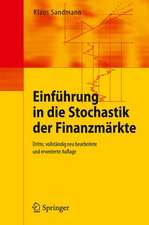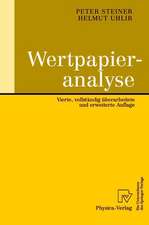Deregulation and Efficiency of Indian Banks: India Studies in Business and Economics
Autor Sunil Kumar, Rachita Gulatien Limba Engleză Hardback – 18 noi 2013
| Toate formatele și edițiile | Preț | Express |
|---|---|---|
| Paperback (1) | 642.83 lei 6-8 săpt. | |
| Springer India – 23 aug 2016 | 642.83 lei 6-8 săpt. | |
| Hardback (1) | 649.22 lei 6-8 săpt. | |
| Springer India – 18 noi 2013 | 649.22 lei 6-8 săpt. |
Din seria India Studies in Business and Economics
- 18%
 Preț: 897.65 lei
Preț: 897.65 lei -
 Preț: 361.78 lei
Preț: 361.78 lei - 18%
 Preț: 1006.24 lei
Preț: 1006.24 lei - 18%
 Preț: 952.89 lei
Preț: 952.89 lei - 20%
 Preț: 883.22 lei
Preț: 883.22 lei -
 Preț: 186.41 lei
Preț: 186.41 lei - 15%
 Preț: 636.94 lei
Preț: 636.94 lei - 15%
 Preț: 647.27 lei
Preț: 647.27 lei - 15%
 Preț: 646.30 lei
Preț: 646.30 lei -
 Preț: 409.89 lei
Preț: 409.89 lei -
 Preț: 372.98 lei
Preț: 372.98 lei -
 Preț: 389.88 lei
Preț: 389.88 lei - 18%
 Preț: 894.03 lei
Preț: 894.03 lei - 15%
 Preț: 644.30 lei
Preț: 644.30 lei - 15%
 Preț: 528.30 lei
Preț: 528.30 lei - 15%
 Preț: 643.65 lei
Preț: 643.65 lei - 15%
 Preț: 644.82 lei
Preț: 644.82 lei - 15%
 Preț: 660.37 lei
Preț: 660.37 lei -
 Preț: 386.00 lei
Preț: 386.00 lei - 20%
 Preț: 559.76 lei
Preț: 559.76 lei - 15%
 Preț: 643.99 lei
Preț: 643.99 lei -
 Preț: 386.68 lei
Preț: 386.68 lei -
 Preț: 390.08 lei
Preț: 390.08 lei -
 Preț: 365.76 lei
Preț: 365.76 lei -
 Preț: 393.52 lei
Preț: 393.52 lei - 15%
 Preț: 656.74 lei
Preț: 656.74 lei - 24%
 Preț: 699.24 lei
Preț: 699.24 lei -
 Preț: 369.80 lei
Preț: 369.80 lei - 15%
 Preț: 642.68 lei
Preț: 642.68 lei -
 Preț: 388.90 lei
Preț: 388.90 lei - 15%
 Preț: 649.87 lei
Preț: 649.87 lei - 15%
 Preț: 645.28 lei
Preț: 645.28 lei -
 Preț: 372.66 lei
Preț: 372.66 lei -
 Preț: 389.17 lei
Preț: 389.17 lei - 20%
 Preț: 569.00 lei
Preț: 569.00 lei - 15%
 Preț: 641.85 lei
Preț: 641.85 lei -
 Preț: 392.97 lei
Preț: 392.97 lei - 15%
 Preț: 643.84 lei
Preț: 643.84 lei - 24%
 Preț: 656.32 lei
Preț: 656.32 lei - 15%
 Preț: 651.34 lei
Preț: 651.34 lei - 15%
 Preț: 641.53 lei
Preț: 641.53 lei - 15%
 Preț: 640.37 lei
Preț: 640.37 lei - 20%
 Preț: 569.86 lei
Preț: 569.86 lei
Preț: 649.22 lei
Preț vechi: 763.78 lei
-15% Nou
Puncte Express: 974
Preț estimativ în valută:
124.22€ • 129.71$ • 102.58£
124.22€ • 129.71$ • 102.58£
Carte tipărită la comandă
Livrare economică 15-29 aprilie
Preluare comenzi: 021 569.72.76
Specificații
ISBN-13: 9788132215448
ISBN-10: 8132215443
Pagini: 323
Ilustrații: XXI, 323 p. 18 illus.
Dimensiuni: 155 x 235 x 21 mm
Greutate: 0.66 kg
Ediția:2014
Editura: Springer India
Colecția Springer
Seria India Studies in Business and Economics
Locul publicării:New Delhi, India
ISBN-10: 8132215443
Pagini: 323
Ilustrații: XXI, 323 p. 18 illus.
Dimensiuni: 155 x 235 x 21 mm
Greutate: 0.66 kg
Ediția:2014
Editura: Springer India
Colecția Springer
Seria India Studies in Business and Economics
Locul publicării:New Delhi, India
Public țintă
ResearchCuprins
1. Introduction.- 2. Banking System in India: Developments, Structural Changes and Institutional Framework.- 3. Measurement of Bank Efficiency: Analytical Methods.- 4. A Survey of Empirical Literature on Bank Efficiency.- 5. Relevance of Non-traditional Activities on the Efficiency of Indian Banks.- 6.Financial Deregulation in the Indian Banking Industry: Has it improved cost efficiency?.- 7. Sources of Productivity Gains in Indian Banking Industry: Is it Efficiency Improvement or Technological Progress?.- 8. Major conclusions, policy implications and some areas for future research.-References.- Index.
Notă biografică
Dr. Sunil Kumar is currently serving as an Associate Professor of Economics at the Faculty of Economics, South Asian University (SAU), New Delhi. He is also associated with Punjab School of Economics, Guru Nanak Dev University, Amritsar. He has more than 20 years of teaching experience in subjects related to Quantitative Methods, Macroeconomics, and Econometrics. His research interests include data envelopment analysis, stochastic frontier analysis, banking efficiency and industrial productivity. He has published more than three dozen research papers in journals of national and international repute including Economic Change and Restructuring, Macroeconomics and Finance in Emerging Market Economies, the American Journal of Accounting and Finance, International Journal of Productivity and Performance Management, International Review of Economics, Benchmarking, Global Business Review, etc. He also wrote a research book entitled, “Productivity and Factor Substitution: Theory and Analysis”. His professional memberships include the Indian Society of Regional Science and Indian Economic Association.
Dr. Rachita Gulati is an Assistant Professor in Economics at Department of Humanities and Social Sciences, Indian Institute of Technology (IIT) Roorkee, Uttarakhand. Before joining IIT Roorkee, she was a core faculty of Indian Institute of Management (IIM) Kashipur, Uttarakhand. Her teaching interests include Applied Econometrics, Managerial Economics, and Quantitative Methods for Economists and her research interests include Efficiency and Productivity Analysis using Frontier Approaches and the Indian Banking Sector. Her research work focuses on financial economics in India and bears important policy implications for further reforms in the Indian banking sector. She has published research papers in journals of national and international repute. In 2008, she received the Best Paper Award from the Global Academy of Business andEconomics Research (GABER), USA.
Dr. Rachita Gulati is an Assistant Professor in Economics at Department of Humanities and Social Sciences, Indian Institute of Technology (IIT) Roorkee, Uttarakhand. Before joining IIT Roorkee, she was a core faculty of Indian Institute of Management (IIM) Kashipur, Uttarakhand. Her teaching interests include Applied Econometrics, Managerial Economics, and Quantitative Methods for Economists and her research interests include Efficiency and Productivity Analysis using Frontier Approaches and the Indian Banking Sector. Her research work focuses on financial economics in India and bears important policy implications for further reforms in the Indian banking sector. She has published research papers in journals of national and international repute. In 2008, she received the Best Paper Award from the Global Academy of Business andEconomics Research (GABER), USA.
Textul de pe ultima copertă
The goal of this book is to assess the efficacy of India’s financial deregulation programme by analyzing the developments in cost efficiency and total factor productivity growth across different ownership types and size classes in the banking sector over the post-deregulation years. The work also gauges the impact of inclusion or exclusion of a proxy for non-traditional activities on the cost efficiency estimates for Indian banks, and ranking of distinct ownership groups. It also investigates the hitherto neglected aspect of the nature of returns-to-scale in the Indian banking industry. In addition, the work explores the key bank-specific factors that explain the inter-bank variations in efficiency and productivity growth. Overall, the empirical results of this work allow us to ascertain whether the gradualist approach to reforming the banking system in a developing economy like India has yielded the most significant policy goal of achieving efficiency and productivity gains. The authors believe that the findings of this book could give useful policy directions and suggestions to other developing economies that have embarked on a deregulation path or are contemplating doing so.
Caracteristici
Examines the effect of deregulation in the Indian banking sector during the post-reforms years, particularly on cost efficiency and total factor productivity Explores the potential determinants of banking efficiency, such as profitability, asset quality, size, etc. and provides the growth behaviour of the alternative measures of banking efficiency Provides a detailed analysis of the nature of returns-to-scale in the Indian banking industry























